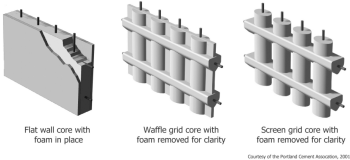Insulated Concrete Forms Explained
Insulated Concrete Forms (ICFs) are forms for cast-in-place, reinforced concrete walls. The forms are left in place permanently to serve as thermal & acoustic insulation, space to run electrical wiring & plumbing, and as backing for gypsum boards on the inside and stucco, brick, or other siding on the outside.
The forms are usually made of foam insulation and are either
- separate panels that are connected with plastic ties or
- pre-formed interlocking blocks
 Different ICF systems also vary in the shape of the resulting concrete within
the wall:
Different ICF systems also vary in the shape of the resulting concrete within
the wall:
- "Flat" systems form even thickness concrete throughout the walls, like a conventionally poured wall.
- "Grid" systems create a waffle pattern where the concrete is thicker at some points than others.
- "Post-and-Beam" (or "screen grid") systems form discrete horizontal and vertical columns of
concrete (no fire resistance).
Also refer to the Construction Overview.
Quad-Lock Insulated Concrete Forms are a flat system using panels and ties. Main advantages (see more under Quad-Lock Advantage):
- The panel and tie design makes Quad-Lock highly
versatile using only standard parts. Quad-Lock can easily be shaped to
form all the design elements of modern buildings - openings, arches, corners,
any angles, and real curves with almost any radius.
- Panel and Tie systems can be shipped and stored
compact (with pre-formed blocks you're shipping and storing lots of air).
- Quad-Lock creates less waste compared to
block systems. With Quad-Lock most parts that needed to be cut can be reused
in the same project.
- The Quad-Lock Panel and Tie system offers low likelihood of form failures by positively connecting the EPS panels at both the horizontal and vertical seams where the pressure during concrete placement is most likely to cause failures.
Related Content:
Construction Overview
ICF vs other methods
